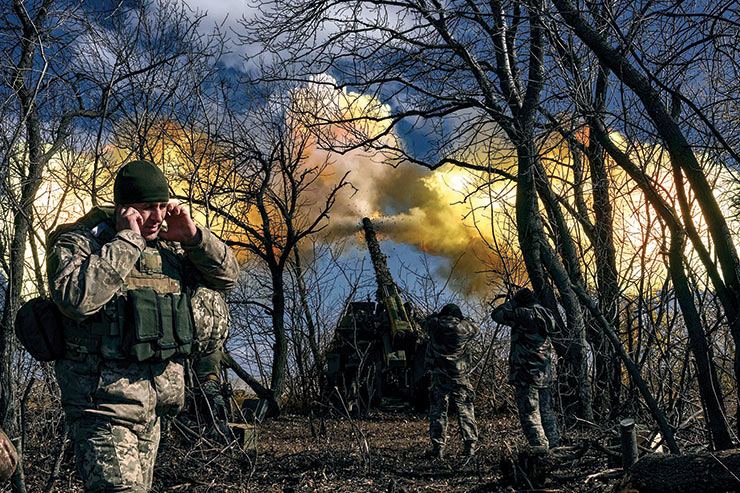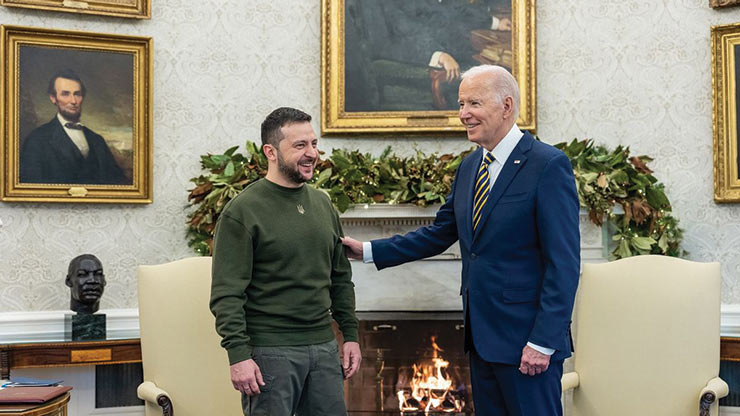
A trumpeted and long-awaited counter-offensive: Since the beginning of the Russian onslaught, the landbridge between mainland Russia and Crimea has been a key point. The Mariupol oblast, or region, serves several strategic purposes all to itself, strengthening the tenuous connection between Russia and its claimed territories, enabling the transport of goods and troops, and overseeing naval transport to and from the Black Sea. Even in the previous Crimean War of 2015, this had been identified as a key asset for Russian ambitions, namely by analyst Steven Pifer: “Mariupol must be a tempting target for the leadership of the so-called Donetsk and Luhansk ‘people’s republics’. If they do not intend to implement Minsk II, seizing Mariupol would be an important step to make a frozen separatist-occupied Donbas economically viable. Mariupol is the port through which much of the steel and other industrial products of the Donbas are exported.”1 Indeed, cutting off Melitopol and Mariupol would spell doom for the entire Russian offensive.
Now, this counter-offensive from the heavily backed Ukrainians was announced, delayed, and re-announced countless times and for innumerable reasons – mostly simply waiting for Western material reinforcements to be delivered and fielded. Naturally, each delay had to be counteracted, in terms of communication, with much hype as the wonder-weapons which would, no doubt, prove invaluable on the eventual battlefield. Additionally, according to Western media outlets, Russian military fecklessness and the hopelessness of their endeavour afforded the luxury of taking time to prepare.
This being said, the slightly drummed-up advertising of the future operation does not contradict how powerful and game-changing these NATO-originating weapons systems can actually be. MLRS launching platforms and drones definitely alter Ukraine’s capacity and Russia’s freedom of movement. Besides, NATO’s support goes beyond equipment: Allied forces command in Europe, as well as all member nations within the alliance, are continuously providing intelligence, training, technology, ammunition, goods and just about everything else the Ukrainians might need, including special forces. Finally, even private contactor troops and a hefty supply of international volunteers found their way to Ukraine, though numbers seem to have dropped in the face of heavy and deterring casualty rates. Vice Ben Makuch writes: “The numbers of foreigners have undeniably dropped from the roughly 20,000 volunteer applications the Ukrainian government quoted that it had in April 2022.”
Either success is limited, or failure is upon the operation
Ukrainian courage and determination cannot be called into question, but success has been limited both for Western-trained troops and for domestic units. A few very limited tactical advances have been made, in Robotine, in the Zaparojie oblast, and on the southern edge of Bakhmut. However, the Russians still seem very far from the breaking point.
“Mariupol must be a tempting target for the leadership of the so-called Donetsk and Luhansk ‘people’s republics’. If they do not intend to implement Minsk II, seizing Mariupol would be an important step to make a frozen separatist-occupied Donbas economically viable. Mariupol is the port through which much of the steel and other industrial products of the Donbas are exported,” says Steven Pifer
If anything, whatever gains have been made in the South, are presumably nullified by losses in the North, in the Luhansk republic. In 2022, Russian troops had been forced into this void by the Ukrainian offensive, leading them to mobilise and attempt to further shift the balance of power in their favour.
The counter-offensive was meant to serve three purposes: apply pressure to the Russian front to create cracks; exploit these cracks with a massive influx of top-notch westernised, mechanised and armoured units, made of elite troops kept in reserve thus far; and finally grab the strategic areas to hopefully reach the sea of Azov. Alas, the most successful pushes breached only the first lines of defence around Surovikine, which counts up to six, in total. Reserve units had to be called in to reinforce frontline operations.
In addition to these tactical attempts, Ukraine has carried out a few moves on a strategic and operational level, ranging from strikes on the rear occupying forces in Crimea (logistics and high-level command posts), to deep UAV strikes within Russian-occupied territory, thus threatening Russian native land. Some of these operations have been militarily successful: two S400 SAM platforms were destroyed in Crimea, drones rendered a Russian supersonic bomber out of service, and French-British cruise missiles destroyed a Kilo-class submarine undergoing repairs in Sebastopol. As spectacular as these actions may have been, their long-lasting effect over upcoming operations in the next few weeks remains limited. But they have the merit of boosting morale for both troops and population and further fuel communication efforts on behalf of Western media as to the likelihood of an eventual victory.
Despite heroic assaults and staunch Western support, Ukraine’s losses are tremendous, and Russia is still far from having depleted its military potential. Causes are several: the combination of drones, artillery, anti-tank ditches, tactical reinforcements and infantry footwork by the Russians – who had months to fortify their defensive positions – is a stark reminder that fire kills and that the advantage always befalls the defender, especially when it possesses aerial and artillery superiority.

In addition to these observations, analysts have come to identify one specific root cause of Ukraine’s limited success over the past four months, despite committing the best of the Western arsenal (namely: Leopard 2 A6 tanks, Challenger 2 tanks, Bradley and Stryker fighting vehicles). They have not had enough time to train: equipment only arrived recently within their hands and there is a big leap between receiving weapon systems and being proficient on them, and then another to being able to use them appropriately when under fire. Even doctrine and new types of manoeuvres must be taught to the Ukrainian command, whose NATO-trained officers died in large numbers in the first 18 months of the conflict. Finally, according to direct witnesses and analysts at RUSI and NATO officials, the Russian army seemed to have gotten its game together before the counter-offensive started.
Ukrainian courage and determination cannot be called into question, but success has been limited both for Western-trained troops and for domestic units. A few very limited tactical advances have been made, in Robotine, in the Zaparojie oblast, and on the southern edge of Bakhmut. However, the Russians still seem very far from the breaking point
The Royal Institute of United Services led an in-depth study of the conflict since its beginnings and draws a far more nuanced picture of the balance of powers that mainstream media generally reports, pointing at tactical mistakes and inadequacies on the Ukrainian side, and plentiful military ability on the Russian one, including that of nullifying the intelligence and UAV-based capabilities of the Ukrainian forces while facilitating its own interarms operations: “Of all UAVs used by the UAF in the first three phases of the war covered by this study, around 90% were destroyed. The average life expectancy of a quadcopter remained around three flights. […] In other instances, the Russians successfully struck the ground control stations of the UAV. In aggregate, only around a third of UAV missions can be said to have been successful.”
So, what now?
Ukrainian forces are heavily depleted, both in troops and equipment. Loud promises to provide high-tech equipment are unlikely to translate into strategic revolutions, if only because training troops effectively and overcoming the military culture barrier will take the kind of time Ukraine simply doesn’t have.
Many Bradley and Stryker vehicles have fallen to attrition, the US will only send the ancient versions of their Abrams tanks, and Germany’s inclination to replace the many Leopard 2 tanks which have been destroyed remains to be seen. And, the delivery of F-16 fighters, no matter how advanced they are, must take into account the long delays necessary for their entering into service and to train pilots on systems, metrics systems, NATO tactics and language.
Ukraine’s troops are spread thin, and their losses (KIA, WIA, MIA) are at worst estimated to reach half a million, with 40 to 80,000 additional deaths due to the latest offensive. Far and large, these numbers greatly exceed Russian losses, no matter of much spin one puts on them, and Russia’s replenishment capacities are unfathomable compared to Ukraine’s.
Politically speaking, we could be on the eve of a shift in the American stance towards Ukraine. NATO stakes are high, as this proxy war is tied to its name, and prolonged failure is likely to further the rift between the US and the rest of the world, with BRICS and new recruits undoubtedly leading the way
Russia produces sevenfold what the combined West does, in terms of shells.
Even more tellingly, Russia has shifted to a war economy without damaging the civilian sector any more than sanctions already had. The IMF indicates that Russian GDP is already on the rebound and is set to increase next year. Also, if Putin’s statement of recruiting 300,000 volunteers and adding them to the 300,000 recruited last fall occurs, we would then be facing numbers indicative of a possible textbook offensive – or at the very least, the ability to permanently man the regions which are already under Russian control.
The future is unpredictable, but it is also possible that Russia will launch a major offensive in the coming weeks or months, weather permitting, once the Ukrainian reserves are finished depleting themselves on the Russian defence lines.
Beyond the theatre of Ukraine, the consequences for Western arms producers will inevitably prove interesting. How their sophisticated kit stands the test of fire could substantially affect their sales, beyond their domestic purchases and their captive clients. Politically speaking, we could be on the eve of a shift in the American stance towards Ukraine, as is suggested by the recent WSJ article regarding the marketplace attack, the tepid welcoming of Zelensky in Washington and the Polish announcement to no longer arm Ukraine. NATO stakes are high, as this proxy war is tied to its name, and prolonged failure is likely to further the rift between the US and the rest of the world, with BRICS and new recruits undoubtedly leading the way.
–The writer is a defence and security industry consultant having varied experience working with medium and large companies majorly in European market. The views expressed are of the writer and do not necessarily reflect the views of Raksha Anirveda








